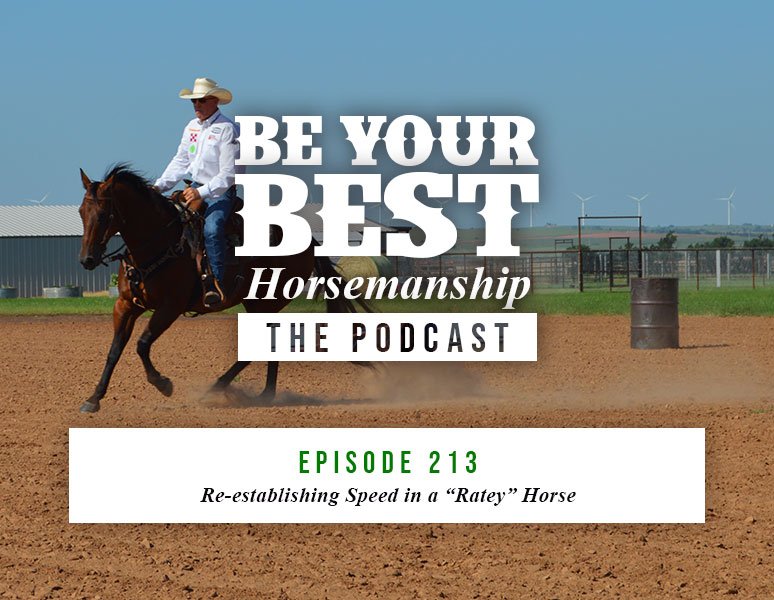Ep 213: Re-establishing Speed in a “Ratey” Horse
In this episode, I’m covering a topic request submitted by one of our listeners, Shelly:
I know that controlling speed is vital, but I would like to see an episode addressing developing top speed back into a barrel horse that is cheating you between barrels. I have a couple that I have built good rate and feel into for good collection in turns, but it seems I could never get that top speed between barrels from one that’s never been on the track. It’s almost as if the horse is always being too careful or too sensitive.
Reverse Engineering the Concept of Speed Control
Whether you’re looking at a barrel horse, a breakaway horse, or any other performance horse, there comes a point when some horses tend to lose that sharpness in speed control as they become more responsive and collected. While this isn’t necessarily a bad thing, it is something that we need to be aware of so that we can have a plan for how to find that happy medium with our speed control.
I’ve done quite a few episodes that covered the topic of speed control, but it has always been presented in the scenario of having too much speed. For many horses, our biggest challenge lies in speed control–but usually, we are trying to decrease their speed so that we can gain better control of feel, timing, balance and collection. In Shelly’s case, the issue of speed control is reversed.
Why Horses Become “Ratey”
For some horses, when we focus on establishing fundamentals like feel and collection for an extended period of time, those horses begin to anticipate us asking for a decrease in speed (usually associated with a stop or turn). While anticipation is not always a negative, it can be a challenge when it comes to maintaining momentum in a turn, specifically in barrel racing.
In instances like this, I can almost always accredit the lack of acceleration to one of two things:
A horse getting “sticky” or front-end loaded
While it may seem like your horse has excellent collection and feel, if you are losing momentum on a consistent basis, this may indicate that your horse has an issue with weight distribution and balance, particularly in the front-end. When a horse becomes “sticky” or “heavy” on the front-end, their speed can be reduced quite drastically.A miscommunication between the rider’s leg pressure and the horse’s understanding of what that leg pressure means.
If your horse is not accelerating upon an increase in leg pressure, they are not understanding what that leg pressure indicates. Some may call this being “dull” or “lazy,” but in reality, the horse’s instinct to anticipate slowing down is simply overriding your cue to go faster.
Re-establishing Speed in a “Ratey” Horse
This can be a somewhat counterintuitive issue to overcome because, as trainers, we don’t want to “untrain” the feel that we have already established; however, we do need to establish a trigger that signals to the horse that it is okay to run fast when leg pressure is applied.
Sometimes, this looks like “breezing” your horse in an open area to re-engage that inherent “flight” mechanism that elicits speed in a horse. But my most frequently used method for re-engaging speed in a “ratey” horse is simply switching things up. For example, if you are working the pattern and doing slow work and you are accustomed to riding to “your spot,” maybe you continue past that spot and lope off in a different direction.
This may cause a moment of confusion for your horse as they are anticipating a different cue–but, that is exactly the purpose of the exercise. You want your horse to listen to your cues, not anticipate them. Of course, there is a fine line between providing quick responses and being able to anticipate the next cue; however, if you find yourself at a point where your horse is making a move or “rating” before you ask them to, that indicates that there is a communication gap between your cues and your horse’s listening skills.
Keeping Your Training Program Diverse
My advice is to keep your training routine diverse for your horse. I used to hear the phrase, “keep them guessing” a lot, but I really don’t want my horse to be guessing – I want them to be listening.
When you are developing your training routine, be mindful that you are not focusing too much on one skill all at once. This can cause those anticipatory behaviors in your horse. Mix it up. Keep it interesting. And, always be in tune with whether your horse is truly listening or if they are simply anticipating and guessing right.
“Be Your Best Horsemanship” is brought to you by Silver Lining Herbs, Classic Equine, Martin Saddlery, Better Horses Network, Purina, Healthycoat, CINCH, Starbar, and Clarifly. These brands have been part of the Phil Haugen Horsemanship team for many years, and their products continue to play an integral role in the success of our performance horse training program. To support these brands, visit our Sponsors tab.




